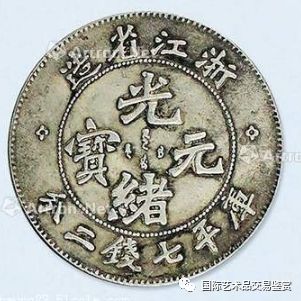浙江地处沿海,通行洋银甚早,清季虽已设厂造币惟大量产制银元是民国以后的事。由于筹建较迟,光绪二十五年浙局开铸后即奉旨停工,机器拆迁他处;营运期间所出银币数额不多,因正面采用魏晋南北朝时期碑文的书法,俗称“魏碑”。然而存世另有一种铭文为楷体之“浙江楷书”,极罕见。惜国内文献记载欠缺,故早年藏界对其出处及年代的说法纷纭,莫衷一是。


光绪元宝是银币珍藏的大类,向来都受到许多藏家的关注,差异版本的光绪元宝都有奇异的韵味,值得藏家深品。在种种差异版本的光绪元宝蟠龙图案机制银币中,币文楷书字样险些如出一辙,唯有“浙江省造光绪元宝”银币独具匠心,接纳奇异的北魏体铸成钱文,打破了一个时期以来钱币书法如出一辙、“千钱一面”的传统名堂。
浙江省首座正式的造币厂是在浙江巡抚廖寿丰向朝廷奏准设浙江银元局后,自德国购置机器,于光绪二十五年(1899)正月开铸。而后来清廷却以各省设局过多、成色重量参差、不便商民使用为由,于该年四月下令除特许外均停铸银元,因此,“浙江省造光绪元宝”银币实际流传下来的数量相当稀少。

由于古钱币具有不可再生的特征,因此,在经历了千万年社会历史的更迭,存世量稀少的古钱币仍具有较大的投资潜力,成为藏品市场中的一颗闪亮之星。尤其是出土于清朝后期的“浙江省造光绪元宝”,近几年来更是以惊人的“身价”让众多“土豪”们大为获利。因此,当人们开始意识到钱币收藏的意义时,古钱币所创造出来的财富神话,已经改写了一代又一代具有智慧头脑藏家们的人生。

此币仔细观察,我们不难发现,钱币的正面分为内圈和外圈两大部分。内圈较大,外圈较小,内圈刻制有“光绪元宝”四个楷体字,且中心有类似波浪形的四瓣花纹进行修饰。外圈则顶部印有“浙江省造”几个小字,底部中央刻“库平七钱二分”,整个币面的造型非常和谐美观,且外圈也有两朵小花分列左右两边,非常具有钱币魅力。

再看钱币的反面,则中央精刻着全身舞动的飞龙,象征着封建社会至高无上的皇权。外圈则印制有英文字体,展现出在清朝年间,我们国家就与国际语言和文化接轨,对外交流早已有很长的历史渊源。与正面不同的是,钱币的反面色泽并不均匀,而是内圈具有较为浓重的金黄色,外圈略显银灰色,这些古钱币无论是用于个人收藏还是市场拍卖,都具有不可估量的现世价值和黑马级别的上涨空间。
光绪元宝是清朝光绪年间流通的货币之一。由湖北两广总督张之洞率先引进英国铸币机器铸造银元和铜元,之后各省纷纷仿效。共有十九个省局铸造,除中央户部,地方省所铸铜元,皆在其正面上缘镌写省名。光绪元宝是大清光绪年流通大面值货币之首,是我国首批引进海外技术的印发流通货币,对于现今也蕴藏了一定历史意义。

近日,众凯国际有幸征得光绪元宝浙江省造当十文一枚,该枚钱币直径2.8厘米。钱币正面珠圈内镌汉文“光绪元宝”字样,外圈是一个由连珠纹组成的圆圈,左右各铸铭文,上镌“浙江省造”四字,下沿镌币值。铜币背面铸刻蟠龙图,其包浆入骨,清秀硬朗,纹路清晰,如刀刻所成,铸造工艺神乎其技。该光绪元宝十分精到,具有鲜明的特色,是古币收藏爱好者梦寐以求的上上之选。

浙江省造光绪元宝成交记录
1888年广东省造光绪宝-----估价:RMB1,110,000---估价日期:2019-03-24
江南省造光绪宝库平七钱二-----估价:RMB2,410,000---估价日期:2017-03-25
户部光绪宝库平二钱银币金-----估价:RMB3,810,000---估价日期:2019-09-16
1897年江南省造光绪宝-----成交价:RMB5,360,000---成交日期:2018-06-25
光绪二十五年1899年-------成交价:RMB1,160,000---成交日期:2017-11-22
1897年江南省造光绪宝-----成交价:RMB3,430,000---成交日期:2017-11-20
1896年湖北省造“本省”---成交价:RMB1,620,000---成交日期:2018-03-18
古玩经纪人:李总:13243741275
微信:13243741275

Zhejiang is located in the coastal area. It was very early to pass through foreign silver. Although there was a mint in the Qing Dynasty, a large number of silver dollars were produced after the Republic of China. Due to the late preparation for construction, the Zhejiang Bureau was ordered to shut down after the founding in the 25th year of Guangxu, and the machines were demolished. During the operation period, the silver coins were not much, because the calligraphy of inscriptions in the Wei, Jin, southern and Northern Dynasties was used on the front, commonly known as "Wei steles". However, there is another kind of Zhejiang regular script with regular script, which is very rare. Due to the lack of domestic documents, there were different opinions about its origin and age in the early Tibetan world.
Guangxu Yuanbao is a large category of silver coins, which has always been concerned by many collectors. Different versions of Guangxu Yuanbao have strange charm and are worthy of deep appreciation. Among the different versions of the silver coins with dragon pattern mechanism of Guangxu Yuanbao, the characters in regular script are almost the same. Only the silver coins of "Guangxu Yuanbao made in Zhejiang Province" are ingenious and accept the strange Northern Wei style to cast coins, breaking the traditional famous Hall of the same coin calligraphy and "one side of a thousand coins" since a period.
The first official Mint in Zhejiang Province was founded in the first month of the 25th year of Guangxu (1899) after Liao Shoufeng, the governor of Zhejiang Province, approved the establishment of Zhejiang silver dollar Bureau. However, the Qing government later ordered that silver coins be stopped except for special permission in April of that year on the grounds that there were too many bureaus in each province, the quality and weight of silver coins were uneven, and it was inconvenient for merchants and people to use them. Therefore, the number of silver coins that "made Guangxu Yuanbao in Zhejiang Province" actually passed down was quite rare.
Due to the non renewable characteristics of ancient coins, after thousands of years of social history changes, the rare ancient coins still have great investment potential and become a shining star in the collection market. Especially in the late Qing Dynasty, "Zhejiang Province made Guangxu Yuanbao", in recent years, many "local tyrants" have made a lot of profits with amazing "value". Therefore, when people began to realize the significance of coin collection, the wealth myth created by ancient coins has rewritten the lives of generations of intelligent collectors.
It is not difficult to find that the obverse of the coin is divided into two parts: the inner ring and the outer ring. The inner ring is larger and the outer ring is smaller. The inner ring is engraved with four regular script characters of "Guangxu Yuanbao", and the center is decorated with four petal patterns similar to the wave shape. The outer ring is printed with "made in Zhejiang Province" on the top and "Kuping seven coins and two cents" on the bottom in the center. The whole coin face is very harmonious and beautiful, and there are two small flowers on the left and right sides of the outer ring, which is very attractive.
Looking at the reverse side of the coin, the flying dragon is carved in the center, symbolizing the supreme imperial power of the feudal society. The outer circle is printed in English, which shows that during the Qing Dynasty, our country was in line with the international language and culture, and had a long history of foreign exchange. Different from the obverse, the reverse color of coins is not uniform, but the inner ring has a relatively thick golden yellow, and the outer ring is slightly silver gray. These ancient coins, whether used for personal collection or market auction, have immeasurable current value and the rising space of black horse level.
Yuanbao of Guangxu is one of the currency circulating in Guangxu period of Qing Dynasty. Zhang Zhidong, governor of Hubei Province and Guangdong Province, took the lead in introducing the British coinage machine to cast silver and copper coins, and then the provinces followed suit. A total of 19 provinces and bureaus cast copper coins. In addition to the central household and local provinces, the names of provinces are engraved on the upper edge of the front. Guangxu Yuanbao is the first currency with large face value circulating in Guangxu, Qing Dynasty. It is the first batch of currency to be issued and circulated by introducing overseas technology in China. It also has certain historical significance for today.
Recently, Zhongkai international was honored to obtain a 10 Wen coin made by Guangxu Yuanbao in Zhejiang Province, with a diameter of 2.8 cm. On the obverse of the coin, the Pearl circle is engraved with the Chinese character "Guangxu Yuanbao", and on the outer circle is a circle composed of continuous beads, with inscriptions on the left and right, the four characters "made in Zhejiang Province" on the top and the value on the bottom. On the back of the copper coin, there is a picture of a flat dragon. It's wrapped in paste and bone. It's beautiful and hard, with clear lines. It's like a knife. The casting process is superb. The Guangxu Yuanbao is very exquisite, with distinct characteristics, which is the best choice for ancient coin collectors.